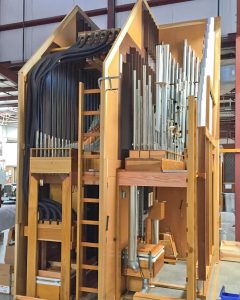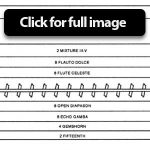Beautiful tone musically expressed is our goal. An organ pipe can produce a sublime sound, but it cannot be fully realized musically unless it is under the precise, minute and flexible control of the organist.
What has held the organ back in expressiveness as compared with most other musical media is its mechanism. We have invested heavily to improve each part of the organ mechanism so that the organist can bring out every aspect of tonal color with ease. All of these mechanical features working together are what we call—The Schoenstein System.
Building an organ in the Schoenstein System is expensive, but the results gained in musical versatility make its application a practical value.
The Schoenstein System has many parts which are discussed in the articles referenced in that section of our web site, but two key elements are highlighted in the two adjacent tabs: Expansion Cell and Double Expression.
 The most important reason for absolute uniformity of chest response under all conditions is the fact that pipes do not have the flexibility to adjust for variations in attack, wind supply, and release as do other wind instruments. By maintaining absolute uniformity, the performer knows what will happen every time a pipe is played. The best way for an artist to achieve lyrical phrasing, clear articulation, and accent is through absolute control of timing, therefore, it is important to enhance speed and accuracy of response.
The most important reason for absolute uniformity of chest response under all conditions is the fact that pipes do not have the flexibility to adjust for variations in attack, wind supply, and release as do other wind instruments. By maintaining absolute uniformity, the performer knows what will happen every time a pipe is played. The best way for an artist to achieve lyrical phrasing, clear articulation, and accent is through absolute control of timing, therefore, it is important to enhance speed and accuracy of response. A good expression box when fully open should not rob the pipes of clear projection and presence to any great degree, but when closed should reduce loudness from at least ff to p. To achieve this, a box must be reasonably sound-proof (with adequate density to control leakage of bass) and must be well sealed when closed; gaps are anathema to good expression-box control. The shades cannot be too thick; their bulk will not permit a full use of the opening. Shades should be able to open nearly 90°. They must be fast-acting and silent. Achieving smooth, continuous expression control is one of the greatest challenges in organ-building.
A good expression box when fully open should not rob the pipes of clear projection and presence to any great degree, but when closed should reduce loudness from at least ff to p. To achieve this, a box must be reasonably sound-proof (with adequate density to control leakage of bass) and must be well sealed when closed; gaps are anathema to good expression-box control. The shades cannot be too thick; their bulk will not permit a full use of the opening. Shades should be able to open nearly 90°. They must be fast-acting and silent. Achieving smooth, continuous expression control is one of the greatest challenges in organ-building.